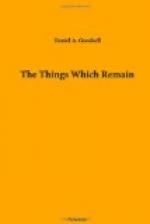such a fact what suits our purpose, and leave a fatal
weakness in our argument. The butterfly does,
indeed, emerge from the coffin of the cocoon and the
seemingly dead pupa. But it is only for a brief
day of life. Then it lays its eggs and dies forever.
It is born to no immortality, but to the most ephemeral
life. The early Church; yea, the Jewish Church,
found rational warrant for belief in immortality and
the resurrection of the body, first in the thought
that it was unjust for those who fought for and brought
in the kingdom of God, to enjoy nothing of what they
secured. So the doctrine of the first resurrection
appears as a contribution of justice to holy life.
Later on, similar reasoning demanded the resurrection
of all. A judgment is necessary, not to acquaint
God with the merits of men, but to acquaint men with
the righteousness of God. This would be impossible
without the resurrection of all. Very close to
this is the reasoning of Kant, summarized as follows:
“Every moral act must have as an end the highest
good. This good consists of two elements, virtue
and felicity, or happiness. The two are inseparable.
But these can not be realized under the limitations
of this existence. Immortality follows as a deduction.
The moral law demands perfect virtue or holiness; but
a moral being can not realize absolute moral perfection
or a holy completeness of nature in this present life.”
It is wholly of faith that men are immortal.
It of necessity can not be demonstrated. The mass
of mankind have believed it, and do believe it, and
it is one of the most difficult of beliefs to escape
from, returning to some skeptical scientists almost
as an intuition, conquering the logic of death and
decay.
[Footnote 8: Biography, Vol. II. p. 322.]
[Sidenote: How Faith Grows.]
It is also true that faith in immortality grows with
the fullness and intelligence of the spiritual life.
It becomes a complete persuasion to the pure in heart.
Yet some scientific facts, as related to man, make
the idea of his extinction improbable, and separate
him from the “beast which perisheth.”
[Sidenote: Men and Brutes.]
[Sidenote: What Brutes Have.]
It is true that much is common to men and brutes.
They walk the same earth; breathe the same air; are
nourished by the same food, which is digested by the
same processes. Their life is transmitted by the
same methods, and their embryonic life is strangely
similar. It is also true that there are strong
mental resemblances. Both love and hate; are
jealous and indifferent; are courageous and cowardly;
they perceive by similar organs; record by similar
mnemonic ganglia; and are within certain limits impelled
by the same motives. Nor can a measure of reason
be denied to animals. While much of what appears
to be mental life is automatic and unconscious response
to an external stimulus reaching a nerve-center, yet
within limits they deliberate; they exercise choice;
and determine routes and methods.




